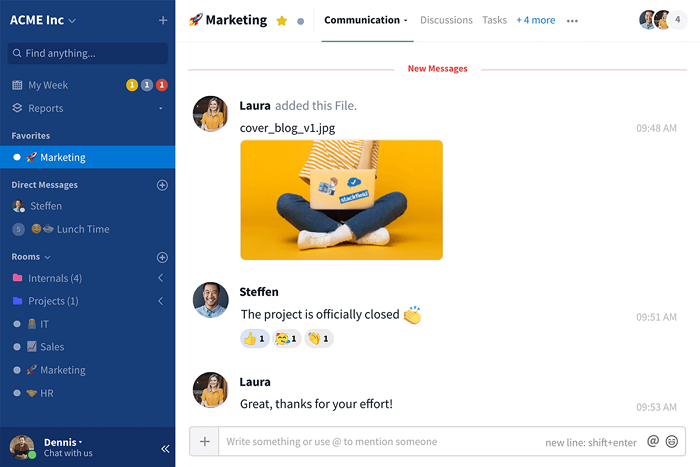The successful realisation of a project often depends on how well the teams involved are working together. In order for cross-departmental collaboration to succeed, it is first and foremost up to the managers. They must break down barriers between the teams and keep an eye on the individual requirements and goals of the teams.
Does your team regularly work on joint projects with other departments and would you like to better prepare them for cross-departmental collaboration? But don't yet know how? In this article, we will show you how you can break down the barriers between individual departments with tried-and-tested practical tips and the benefits of cross-team collaboration.
What does cross-departmental collaboration actually mean?
We speak of cross-departmental collaboration when several departments or teams within an organisation want to achieve common goals. This requires tasks or projects to be processed across functions and work processes to be harmonised.
Successful cross-team collaboration means that
- decisions are made jointly with other departments,
- resources are shared across team boundaries,
- all relevant information is exchanged at all times.
You can introduce cross-team collaboration on a temporary basis as part of projects. Or you can use it to permanently improve the networking of individual departments.
What are the benefits of cross-departmental collaboration?
Avoidance of duplication of work
If several teams work together cross-functionally, knowledge and best practices can be shared and do not have to be created by each department itself. Turning away from silo thinking therefore eliminates a lot of duplication of work.
Process improvement across departmental boundaries
If processes and workflows in a department are improved, it is no longer just one department that benefits from this further development: other departments can learn from the optimisations through exchange and collaboration and apply them directly to their own department.
Promoting innovation
Cross-departmental collaboration is usually cross-functional. This means that very different perspectives and approaches come together. This gives established processes a new dynamic, which can lead to new solutions.
Increasing employee motivation
The motivation of individual employees is no longer limited by departmental boundaries. Thanks to cross-departmental collaboration, these employees can be encouraged and also realise complex ideas or projects. This gives individual employees the opportunity to develop better and achieve new best performances. Valuable talents therefore have fewer motives to change jobs.
5 practical tips on how to improve cross-departmental collaboration
For cross-team collaboration to work, the barriers between the individual departments must be broken down. Possible obstacles are a lack of communication channels, conflicting objectives, unclear targets or working with sensitive data. The human factor also plays a role.
- Put an end to information silos: Use a collaboration tool, to make resources visible across departments. This way, all departments involved benefit equally. An all-in-one collaboration tool such as Stackfield is ideal for data management and the joint editing of documents in real time. This gives all teams involved a fixed digital place to work together and certain information can be shared with other departments if required. Thanks to the user and rights management on Stackfield, you can ensure that sensitive data is only accessible to authorised team members.
- Set clear goals: Conduct quarterly joint goal-setting workshops in which the teams can harmonise their goals and identify synergies. It must be clearly and bindingly defined what the project objective is or what the purpose of long-term cross-team collaboration in the corporate context is. No physical presence is required for the workshop. A video conference in which all common goals are recorded is sufficient.
- Smooth communication: Keep daily communication and the exchange of information as simple and straightforward as possible. You can use a digital tool such as Stackfield, which bundles all communication channels on one platform. Easier communication, even across team boundaries, creates closeness and reduces possible resistance. Stackfield offers the opportunity to communicate directly with other departments via chat as well as audio and video calls.

There are numerous communication channels on Stackfield, including team chats
- Clear responsibilities: If responsibilities are not clearly defined, collaboration will sooner or later come to a standstill. If two or more departments are working on a project, it must be clear who takes the lead role and therefore acts as the contact person. The person(s) chosen is / are responsible for allocating tasks, informing all those involved about important progress / changes and regularly reviewing the project status and taking action if necessary.
- Promote soft skills: Strengthen important key competences in your employees, such as active listening, cooperation and the ability to deal with conflict. With appropriate workshops, seminars and, for example, the introduction of a conflict culture, you can make your team fit for challenges such as conflicts of objectives.
Conclusion: Cross-departmental collaboration as a real opportunity
Cross-departmental collaboration definitely has the potential to sustainably equip companies for current and future challenges. It also promotes innovation, efficiency and productivity in day-to-day work. This in turn benefits the motivation of your employees. With a few strategies and practical tips, cross-team collaboration can also be easily improved in your organisation. A collaboration tool such as Stackfield can support you in implementing these tips and also offers many opportunities to improve collaboration within the team and the company.
Almost finished...Please click the link in the email and confirm your email adress to complete the subscription process.
Never miss a post. Get awesome insights in your inbox.